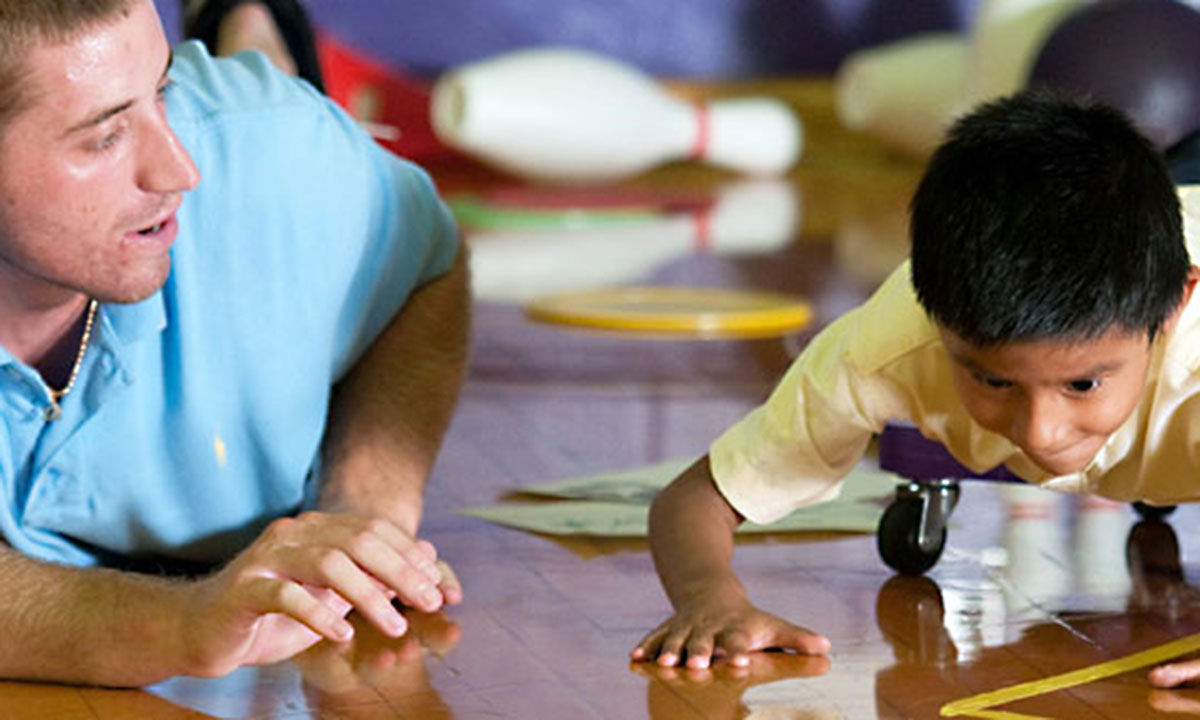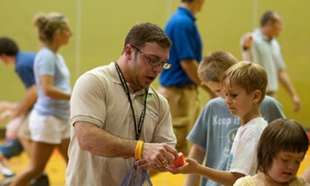Overcoming barriers
News
Professor empowers children with different abilities, their parents, as well as tomorrow's teachers
By Colleen Dixon
When this feature was originally published in October 2010, Project CLIMB was a separate program but then became part of the Overcoming Barriers Project. Funded by a grant to run a Physical Activity and Nutrition Mentoring Program for individuals with disabilities, Overcoming Barriers offers various programs including aquatics and individual sports/recreational activities.

JMU is well known for its community outreach projects. Tom Moran, assistant professor of kinesiology, is striving to increase JMU's interaction with the community by meeting the needs of children and adults with disabilities in sports and recreation. Several programs he has devised since coming to JMU two years ago not only give his teacher education students experience working with young children with disabilities, but they also provide a vital service to parents whose children do not have access to many sports programs in the Harrisonburg and Rockingham County area.
Project CLIMB, Children Learning to Improve Movement Behaviors, is a 10-week program that gives children with disabilities one-on-one attention and assistance from JMU's Adapted Physical Education program students. As each child has specific needs and challenges, students must develop an individualized program of learning that focuses on developing motor skills. As the program progresses, the students work in pairs and then with small groups of children.
"I knew going through the undergraduate teacher preparation program that the hands on experience was essential to helping me not only feel adequate to work with children of disabilities, but also to create that interest and that passion. Until students get the hands-on experience outside of the classroom, it really doesn't mean anything. It's nice when I'm lecturing on autism and someone pipes up and asks, 'Is that what my student has and is that why he starts getting overwhelmed when we're in a certain situation?' It makes the content just that much richer for my teacher education students."
Creative environment provides multitude of experiences
Moran developed Project CLIMB by putting together parts of other adaptive learning programs he had observed. "The year prior to my coming to JMU, I was able to visit some of these places—I was able to observe these programs and blend my ideas to develop Project CLIMB. Some programs do just one on one the whole time for 10 weeks. [Other universities don't] assign teachers to a specific child; they work with somebody different throughout the hour they're there. I liked the idea of one-on-one [attention], because students get to see the growth of the student across the program. At the same time, I don't want them to only gain experience with a child with Down's syndrome, or a child with cerebral palsy. I wanted to create an environment where they can get multiple experiences. That's where I came up with the progression of one-on-one, then pairs, then small groups. By the end of the program they'll have opportunities across different settings, and also working with different students. It's really the best of both worlds."
John Parks ('09) enjoyed the program for the instant feedback and that the program improved his teaching ability. "Dr. Moran impressed me with the way he was able to get us comfortable with working with kids with disabilities, something a lot of us had never done before," says Parks. "It can be intimidating, but he gave us the tools to break down any barriers and get us able to give the kids a quality experience."
A service to the community
We're able to provide a service in the community," says Moran. "Children who, unfortunately, didn't have a program when everyone else was joining Little League or Youth Soccer now have their own program that they can call their own and take ownership of."
Parents are excited about the opportunities opening for their children. "I get a lot of good feedback from the parents not only about improving the skill levels of their kids, but also about how it improves their self-confidence and self-esteem," says Moran." Some of the kids have now gone on to join other programs in the community. They come back and say, 'I didn't even think they would join project CLIMB, and now they're coming home and saying, "Can I join a baseball team? Can I get involved in a different program?"' So we're starting to see some self-actualization come out of it and some improved self-image. Children who have been through the Project CLIMB program go from thinking "I can't do these things," or getting frustrated, so saying, "Well, what can I do next?"
Parents have told Moran that they want the children to learn how to ride a bike or how to swim, or continue to work on their motor skills so they can throw and catch in the backyard. "The spinoff of this program is we've been able to create is a community-based adapted physical education program that, hopefully, we'll be able to bring under the JMU umbrella," says Moran. "We're able to provide either one-on-one or small-group instruction for children with disabilities through the academic year, and some during the summer." On a donation basis, parents can sign up for various programs.
Moran adds, "We have a mechanism where we can continue to provide services year-round. In 2009 we created, as an offshoot to Project CLIMB—the Helping Hands program, where instructors can assist children or adults with disabilities in the community." Examples he gives are an adult who wants to go to a local gym and work out or a child who wants to sign up for a self-defense class at Boys and Girls Club. Now parents can sign up for those community programs, and we'll provide an instructor who can accompany them and provide one-on-one support within the larger group setting, as a mechanism to get the kids out into the community."
"I always look at serving two purposes," Moran says. "I'm meeting the needs of my students by giving them hands-on experience in education, but we're also filling a need for these programs in the community."
